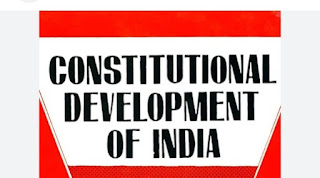We can divide the constitutional development of India into two parts.
1. Under the rule of the East India Company, (1600-1858) and
2. Under the rule of the British Government (1858-1947)
During the time when the East India Company was in power till 1858, the British Parliament kept on controlling the Company's rule by passing various Acts or Charters on various occasions and when it took the rule of India in its own hands, it made strange laws for the rule of India. We include all those orders and laws in the constitutional development of India. For example
Charter of 1600 A.D.
The constitutional development of India started with the establishment of the East India Company. This work was done through a Charter which was called the Charter of 1600. Through this Charter, Queen Elizabeth I established the 'East India Company' on 31 December 1600 A.D. and gave it the right to trade in the eastern countries for 15 years.
At the time of establishment, the total capital of the company was 30133 pounds and it had a total of 217 partners. The entire administration of this company was handed over to a council at the top of which were the Governor and Deputy. There were governors and 24 other members. This was called the 'Governor and his Council'. It is worth noting that later this council was called the 'Court of Directors' and 'Board of Directors'.
> 1726 Gazette
By this Gazette, the Governors of Kolkata, Mumbai and Madras Presidencies and their Councils were given the 'power to make laws'.
Earlier this power was vested in the Board of Directors in England.
> Regulating Act of 1773
The Act passed on the recommendation of the 'Secret Committee' (BPSC-94) constituted by the then British Prime Minister 'Louis North' was called the 'Regulating Act of 1773'. Its main objective was to control the company's activities both in India and Britain and to eliminate the defects prevalent in the company. The company had two main centres of activities.
1. England 2. India
For supervision of the entire administration of the company, there were two institutions in England:
1. Court of Directors,
2. Court of Proprietors
Both these institutions were also parts of the Home Government. The previous institution was the executive of the company in England. It had 24 directors. They were elected every year by the Court of Proprietors. The Board of Proprietors elected a Chairman and a Vice-Chairman from among its members every year. The Chairman was the Chief Executive Officer of the company.
Now under this Act, the tenure of the Board of Directors was made four years instead of one year. It was also provided that one-fourth (1/4) of the total number of members (24) of the Court of Directors would retire every year. Again, only those people would have the right to elect the directors of the company who had been shareholders of 1000 pounds in the company at least one year ago. It is noteworthy that before this Act, the Board of Directors of the company was elected by the shareholders of 500 pounds of the company.
• In the Indian context, in the company administration, the administrator of the Port William Presidency of Bengal was made the Governor General of the English territories through this Act. That is, Bengal (Calcutta), Mumbai and Madras Presidencies were interconnected, by this Act, the Governor of Bengal was made the Governor General of all three Presidencies by making them subordinate to the Bengal Presidency.
All the military and civil powers of Hassan were handed over to the Governor General and his four-member council and the Lieutenant General was given the right to give the deciding vote for the majority in the decision. 'warren Hastings' was appointed the first Governor General. The other 4 members of the Executive Council were Philip Francis, Clevering, Manson and Barwell.
• Under the Act, a Supreme Court was established in Calcutta in 1774. Sir Elijah Impey was made the Chief Justice and three others, Chambers, Lemaster and Hyde were made judges. It was a court of record. Appeals against it were made in the Privy Council.
• By this Act, the British government's control over the company was strengthened through the Court of Directors (the governing body of the company). It was made compulsory for the company to give information about Indian revenue, civil and military matters to the British government. By this Act, the employees of the company were prohibited from doing private business without obtaining a license and from accepting gifts and bribes from Indian people.
> Act of Settlement, 1781
This Act was made on the basis of the suggestion of Edmund Burke, the chairman of the Select Committee of the British Parliament, to remove the serious practical defects inherent in the Regulating Act, 1773. It is also called the 'Amendment Act' or Bengal Judicature Act, 1781.
• Through this Act, the Government of Calcutta was also given the authority to make laws for Bengal, Bihar and Orissa. Thus, now the Government of Calcutta got two sources of making laws. First, under the Regulating Act, it could make laws for the Calcutta Presidency and second, under the Act of Settlement, it could make laws for the Diwani regions of Bengal, Bihar and Orissa.
• It was also ordered to keep in mind the religious and social customs and traditions of the Indians in the editing of orders and laws for the Supreme Court.
• Governor General-in-Council was freed from the jurisdiction of the Supreme Court. That is, now whatever rules the Governor General's Council makes, it will not be necessary to register them with the Supreme Court.
An appeal against the provincial courts could be made to the Governor General's Council. Further, cases worth 5000 pounds or more could be sent to the British Emperor with the Council.
• By limiting the power of the Supreme Court, its revenue jurisdiction was abolished and instructions were given to implement new laws keeping in mind the local rules. Thus, this Act removed many disputes and difficulties of the Regulating Act.
Its objective was to strengthen the government. It also solved the problem of revenue and established Revenue Boards. Along with this, emphasis was also laid on not violating the social and religious customs of Indians in making laws and implementing them in India.
Note: With the objective of removing the defects prevalent in the Regulating Act, first the 'India Act' was introduced in 1783 and then Fox's India Bill was introduced in November 1783. But both the above bills could not be passed. Hence, due to the bill presented by Fox not being passed in the House of Lords, the coalition government of Lord North and Fox had to resign. It is worth noting that this is the first and last example of the fall of an English government on an Indian issue. Thereafter Pitt's India Act of 1784 was introduced.
Pitt's India Act of 1784:
After the failure of the Act of Settlement 1781, Pitt's India Act was the first legal document of the claim of ownership of the British Crown on the Indian territories acquired by the Company, titled British Dominion in India.
The main features of this Act are as follows. As-
• Through this Act, the commercial and political activities of the company were separated. While keeping the commercial activities in the hands of the directors of the company, a 6-member Board of Control was established in England to control and supervise the political activities (military, civil and revenue related).
It is worth noting that without the permission of the Board of Control, the Governor General did not have the right to start a conflict with any native king or to assure help. The right to appoint and remove these members was handed over to the Emperor.
Out of the 6 members, one was the Chancellor of Exchequer, one was the State Secretary and 4 persons were the members of the Privy Council. Thus, now there were two rulers of the Indian colony, first- the Board of Directors of the company, and second, the Emperor through the Board of Control. This situation continued till 1858 AD.
• The number of members of the Governor General's Council was reduced from four to three. This council was given the power to supervise administration in India such as military power, issues, treaties, revenue and native princely states etc.
• The number of members of the Provincial Council was reduced from 4 to 3. One of these members was made the commander of the province.
• This Act gave the Governor General the right to dismiss provincial governments in case of non-compliance with the central government.
• A court was established in England to prosecute the illegal activities of British officers appointed in India.
• This Act prohibited the company employees from accepting gifts.
• Under this Act, it was made mandatory for the Governor General to take permission from the company directors before going to war or entering into a treaty with native kings.
Act of 1786
This Act empowered the Governor General to override the decision of his council under special circumstances and implement his own decision. The Governor General was also given the powers of Commander-in-Chief. Lord Cornwallis was the first to receive both these rights.
♦️ Note: This is the first part of the article Constitutional Development of India. To understand the Constitutional Development of India in full detail, you must read its next parts as well, only then conceptual clarity will develop. The next parts are given below-






